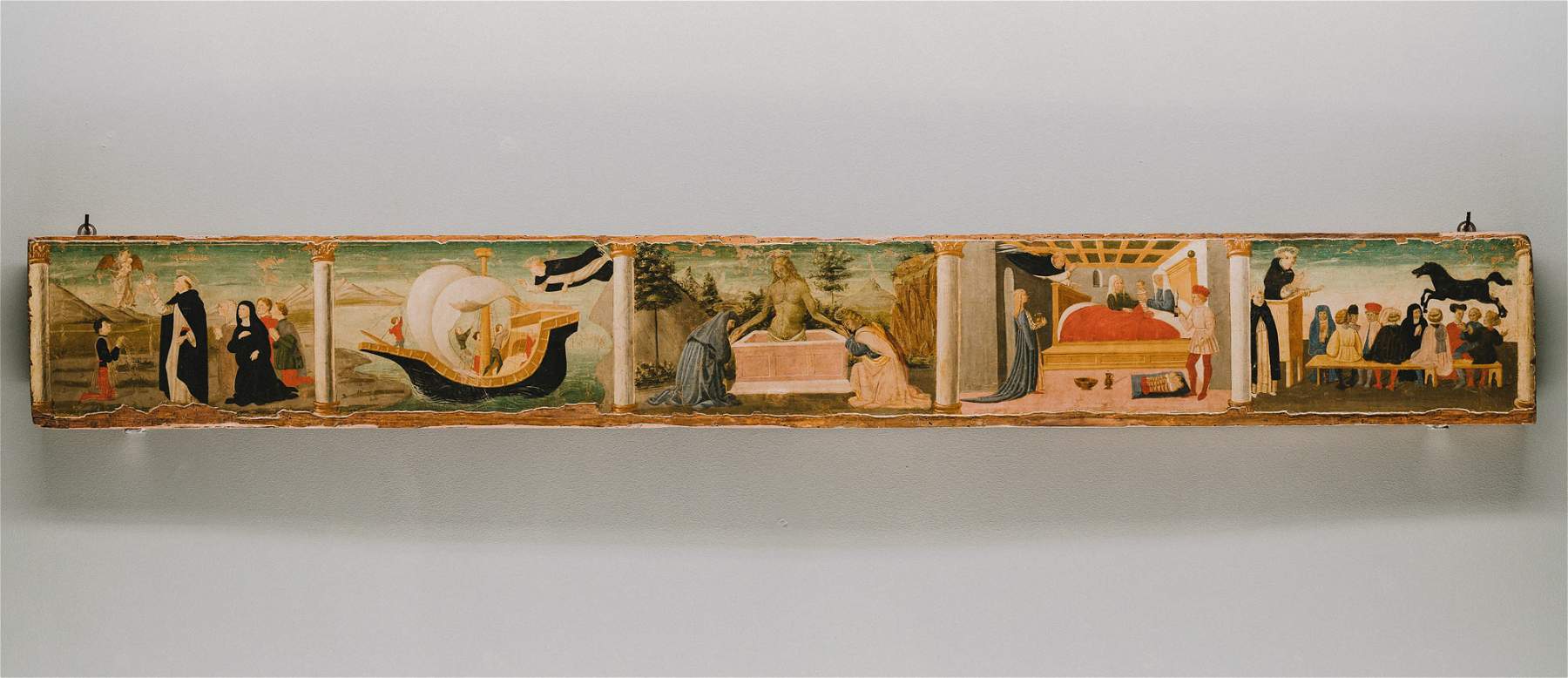It is the story of an important restitution that the Museo d’Arte Sacra di San Piero in Mercato in Montespertoli (Florence) tells from May 14, 2022, to Jan. 8, 2023, as part of the exhibition La predella degli Uffizi salvata al Castello di Montegufoni. The story tells of a Uffizi work rescued from the raids of the Nazi army and the destruction of World War II, exhibited in Montespertoli as part of the Terre degli Uffizi project, carried out by the Galleries together with the Fondazione CR Firenze as part of their respective Uffizi Diffusi and Piccoli Grandi Musei projects.
The work is a fifteenth-century Florentine workshop predella (a painted ’step’ that stood at the base of a Renaissance ’square altarpiece’) where the Stories of St. Pier Martyr and, in the central panel, Christ in Pity are depicted. As part of the exhibition, the panel connects with coeval works already in the museum and from the area. The predella, requisitioned from a convent during the Napoleonic Suppressions of religious buildings in 1808-1810, was located in the mid-nineteenth century in the Gallery of Ancient and Modern Paintings of the Academy of Fine Arts, forerunner of today’s Accademia Gallery, along with other works used as models for teaching aspiring artists who attended the school. The choice of the predella for the exhibition also finds symbolic grounding in the history of the last century: during World War II, in fact, the work had been sheltered in the nearby Castello di Montegufoni, an ancient medieval fortress of the Acciaioli family that in the early twentieth century was acquired by the English noble family Sitwell. When the dangers of air raids forced the safekeeping of the Florentine artistic heritage, Montegufoni took in such masterpieces as Giotto ’s Majesty and Botticelli’s paintings, among the many works arriving from the Uffizi. Today the predella, returning close to the place of its rescue, bears witness to an important piece of 20th-century history.
The Castle of Montegufoni is encountered just outside Montespertoli, in a beautiful cypress forest. It is an ancient medieval building owned by an ancient Florentine family of wealthy bankers, the Acciaioli. Apparently Niccolò Acciaioli, a friend of Petrarch and Boccaccio, was born there. Around the middle of the seventeenth century, partly at the urging of Cosimo II de’ Medici, it was radically modernized, becoming a meeting place for the Florentine nobility until the entire eighteenth century. After numerous changes of ownership during the nineteenth century, in 1909 the fortress was purchased by Englishman Sir George Sitwell, for his son Sir Osbert. The Sitwells elected to make the castle their permanent home only in 1966, but even earlier they stayed there for a long time, inviting artists and men of letters and investing in embellishment and enrichment works including, in 1922, decorations with masks and Harlequins executed by Gino Severini. During World War II, after the requisition of property from the Sitwells, who, British, were on the enemy list for Italy, the castle was elected by the then Superintendency as a refuge for works of art, as it was far from the crossing of the front line. In more deliveries, the works arrived in Montegufoni in November 1942 to remain there until 1945; its custodian was Guido Masti, later awarded the title of Knight of Merit of the Republic for this. Among the treasures kept were such masterpieces as Giotto’s Majesty and Botticelli’s panels. When the war ended, the Sitwells remained at the castle, where Sir Osbert died, in 1969. Not long after, the fortress was sold to the Posarelli family (current owners), who restored it, changing its use and purpose.
“A predella without the altarpiece to which it was connected, from a still mysterious 15th-century Florentine workshop,” comments Uffizi director Eike Schmidt. “Putting this work temporarily in the Montespertoli Museum subjects it to the scrutiny of scholars and the curious, in the hope that someone will resolve the many questions the work still leaves open. This is an unusual operation because it does not propose solutions from above but intends, on the contrary, to stimulate the curiosity and participation of visitors. The ’Uffizi Lands’ become, in this way, also an opportunity for scientific debate.”
“Precisely after the disasters of World War II, one of the Fathers of the Italian Constitution, Piero Calamandrei, declared that every work of art lost in the conflict was ’an area of memory that is obscured,’” says Roberto Riccardi, commander Carabinieri Tutela patrimonio culturale. “To return an asset to the community is to restore light. This is our task, and we want to light many more.”
“This second stage of our project is much more than an exhibition,” stresses Luigi Salvadori, president of the Fondazione CR Firenze: “it is a pleasant opportunity to discover a work saved from the raids of the war and to find, perhaps, some answers to the mysteries it conceals. Its return to the place where it was rescued is also an opportunity to marvel again at the beauty of our territory, which perhaps is not appreciated as it should be.”
 |
| Uffizi Diffusi, Montespertoli showcases 15th-century predella rescued from Nazi thefts |
Warning: the translation into English of the original Italian article was created using automatic tools. We undertake to review all articles, but we do not guarantee the total absence of inaccuracies in the translation due to the program. You can find the original by clicking on the ITA button. If you find any mistake,please contact us.